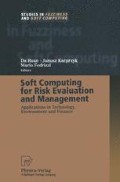Abstract
This paper proposes an approach for the multivariate modelling of time series with neuro-fuzzy systems. The fuzzy rule model is based on adaptive B-splines which can approximate any given input-output data series of low dimension. To efficiently describe high-dimensional input data, statistical indices are extracted to feed the fuzzy controller. The original input space is transformed into an eigenspace. If a sequence of training data are sampled in a local context, a small number of eigenvectors which possess larger eigenvalues provide a good summary of all the original variables. Fuzzy controllers can be trained for mapping the input projection in the eigenspace to the outputs. Experiments of time series prediction validate the concept.
Access this chapter
Tax calculation will be finalised at checkout
Purchases are for personal use only
Preview
Unable to display preview. Download preview PDF.
References
J. S. Albus. A new approach to manipulator control: The Cerebellar Model Articulation Controller (CMAC). Transactions of ASME, Journal of Dynamic Systems Measurement and Control, 97: 220–227, 1975.
W. Böhm, G. Farin, and J. Kahmann. A survey of curve and surface methods in cagd. Computer Aided Geometric Design, 1: 1–60, 1984.
G. E. P. Box and G. M. Jenkins. Time series analysis. Holden Day, San Francisco, 1970.
S. L. Chiu. Selecting input variables for fuzzy models. Journal of Intelligent and Fuzzy Systems, 4: 243–256, 1996.
J.-S. R. Jang. ANFIS: Adaptive-network-based fuzzy inference system. IEEE Transactions on System, Man and Cybernetics, 23 (3): 665–685, 1993.
J.-S. R. Jang, C.-T. Sun, and E. Mizutani. Neuro-Fuzzy and Soft Computing. Prentice Hall, 1997.
V. Lacrose and A. Tilti. Fusion and hierarchy can help fuzzy logic controller designers. In IEEE International Conference on Fuzzy Systems, Barcelona, 1997.
S. Lotvonen, S. Kivikunnas, and E. Juuso. Tuning of a fuzzy system with genetic algorithms and linguistic equations. In Proceedings of Fourth European Congress on Intelligent Techniques and Soft Computing, Aachen, 1997.
S. Mitaim and B. Kosko. What is the best shape of a fuzzy set in function approximation. In IEEE International Conference on Fuzzy Systems, pages 1237–1243, 1996.
E. Oja. Subspace methods of pattern recognition. Research Studies Press, Hertfordshire, 1983.
T. Takagi and M. Sugeno. Fuzzy identification of systems and its application to modelling and control. IEEE Transactions on System, Man and Cybernetics, SMC-15(1): 116–132, 1985.
L. A. Zadeh. Fuzzy logic = computing with words. IEEE Trans. on Fuzzy Systems, 4 (2): 103–111, 1996.
J. Zhang and A. Knoll. Constructing fuzzy controllers with B-spline models-principles and applications. International Journal of Intelligent Systems, 13 (2/3): 257–285, 1998.
J. Zhang and A. Knoll. Designing fuzzy controllers by rapid learning Fuzzy Sets and Systems, 13 (2), 1998.
J. Zhang, A. Knoll, and I. Renners. Efficient learning of non-uniform B-splines for modelling and control. In International Concerence on Computational Inteligence for Modelling, Control and Automation, Viena, pages 282–287, Viena, 1999.
Author information
Authors and Affiliations
Editor information
Editors and Affiliations
Rights and permissions
Copyright information
© 2001 Physica-Verlag Heidelberg
About this chapter
Cite this chapter
Zhang, J., Knoll, A. (2001). Neuro-Fuzzy Modelling of Time Series. In: Ruan, D., Kacprzyk, J., Fedrizzi, M. (eds) Soft Computing for Risk Evaluation and Management. Studies in Fuzziness and Soft Computing, vol 76. Physica, Heidelberg. https://doi.org/10.1007/978-3-7908-1814-7_9
Download citation
DOI: https://doi.org/10.1007/978-3-7908-1814-7_9
Publisher Name: Physica, Heidelberg
Print ISBN: 978-3-662-00348-0
Online ISBN: 978-3-7908-1814-7
eBook Packages: Springer Book Archive

